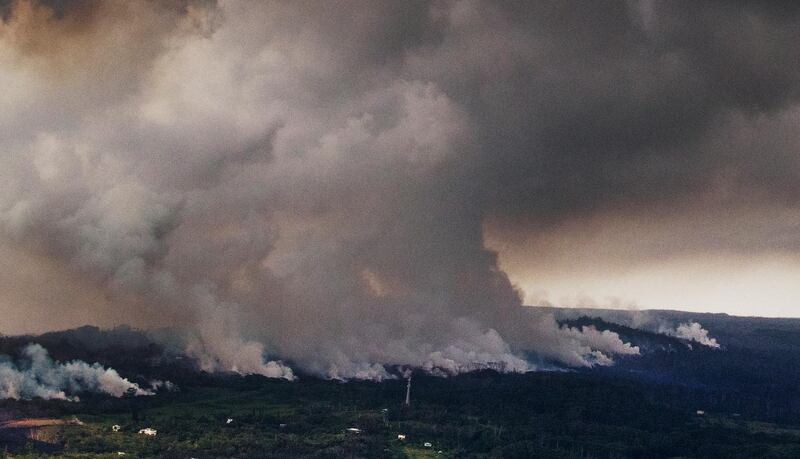Hawaii’s Kilauea volcano erupted anew early Thursday with little sound and only modest fury, spewing a steely gray plume of ash about 9,000 metres into the sky that began raining down on a nearby town.
The explosion at the summit came shortly after 4am local time, following two weeks of volcanic activity that sent lava flows into neighbourhoods and destroyed at least 26 homes. Scientists said the eruption was the most powerful in recent days, though it probably lasted only a few minutes.
Geologists have warned that the volcano could become even more violent, with increasing ash production and the potential that future blasts could hurl boulders the size of cows from the summit.
Toby Hazel, who lives in Pahoa, near the mountain, said she heard “a lot of booming sounds” Thursday. Those came after days of earthquakes.
“It’s just time to go — it really, really is,” she said, preparing to leave town. “I feel so sorry for the people who don’t go, because they don’t have the money, or don’t want to go to a shelter and leave their houses.”
Some people in the community closest to the volcano slept through the blast, said Kanani Aton, a spokeswoman for Hawaii County Civil Defense, who spoke to relatives and friends in the town called Volcano.
At least one person who was awake heard nothing. Epic Lava tour operator John Tarson is an early riser and only learned about the eruption after receiving an alert on his phone. The plume, a towering column of ash reaching into a hazy sky, looked different than others he’s witnessed, because of its sheer height.
“What I noticed is the plume was just rising straight into the air, and it was not tipping in any direction,” he said. “We’ve been expecting this, and a lot of people are going to see it and get excited and scared.”
Tour guide Scott Wiggers didn’t hear the eruption either and wasn’t aware anything happened. Later in the morning, he picked up four travellers for a tour and headed toward the volcano with the hopes of seeing “some action.” But it was raining too hard for them to see much.
The only sign of the eruption he encountered was ash covering the back bumper of his truck.
Residents as far away as Hilo, about 50km from Kilauea, were starting to notice the volcano’s effects. Pua’ena Ahn, who lives in Hilo, complained about having laboured breathing, itchy, watery eyes and some skin irritation from airborne ash.
The National Weather Service issued an ash advisory and then extended it through early evening, and county officials distributed ash masks to area residents. Several schools closed because of the risk of elevated levels of sulphur dioxide, a volcanic gas.
The immediate risk health risk comes from ash particles in the air, said Dr Josh Green, a state senator who represents part of the Big Island.
Anyone with respiratory difficulties, such as asthma or emphysema, should limit exposure to the ash, Dr Green said.
“People need to stay inside until the winds shift and the ash has settled,” he said.
Extended exposure to sulphur dioxide can increase risk of bronchitis and upper respiratory infections in the long run, according to findings of a study Dr Green worked on with other experts published in 2010 in the Journal of Toxicology and Environmental Health.
The Federal Aviation Administration extended a restriction on aircraft from entering the airspace up to 9,100 metres above Kilauea’s summit. The prohibition applies to an eight-kilometre radius around the crater.
Thursday’s eruption did not affect the Big Island’s two largest airports in Hilo and in Kailua-Kona.
The crater spewing ash sits within Hawaii Volcanoes National Park, which has been closed since May 11 as a safety precaution over risks of a violent eruption.
Scientists warned on May 9 that a drop in the lava lake at the summit might create conditions for a large explosion. Geologists predicted such a blast would mostly release trapped steam from flash-heated groundwater.
Kilauea, one of the world’s most active volcanoes, has been erupting continuously since 1983. It’s among the five volcanoes that form the Big Island, and it’s the only one actively erupting. An eruption in 1924 killed one person and sent rocks, ash and dust into the air for 17 days.
Scientists cannot say why the eruption is happening now, given that Kilauea has been active for 35 years.






